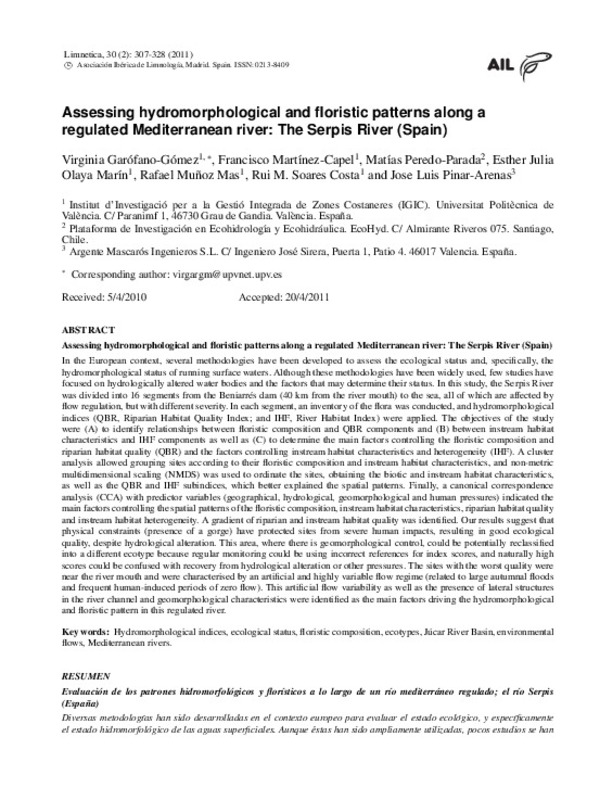|
Resumen:
|
[EN] In the European context, several methodologies have been developed to assess the ecological status and, specifically, the hydromorphological status of running surface waters. Although these methodologies have been ...[+]
[EN] In the European context, several methodologies have been developed to assess the ecological status and, specifically, the hydromorphological status of running surface waters. Although these methodologies have been widely used, few studies have focused on hydrologically altered water bodies and the factors that may determine their status. In this study, the Serpis River was divided into 16 segments from the Beniarrés dam (40 km from the river mouth) to the sea, all of which are affected by flow regulation, but with different severity. In each segment, an inventory of the flora was conducted, and hydromorphological indices (QBR, Riparian Habitat Quality Index; and IHF, River Habitat Index) were applied. The objectives of the study were (A) to identify relationships between floristic composition and QBR components and (B) between instream habitat characteristics and IHF components as well as (C) to determine the main factors controlling the floristic composition and riparian habitat quality (QBR) and the factors controlling instream habitat characteristics and heterogeneity (IHF). A cluster analysis allowed grouping sites according to their floristic composition and instream habitat characteristics, and non-metric multidimensional scaling (NMDS) was used to ordinate the sites, obtaining the biotic and instream habitat characteristics, as well as the QBR and IHF subindices, which better explained the spatial patterns. Finally, a canonical correspondence analysis (CCA) with predictor variables (geographical, hydrological, geomorphological and human pressures) indicated the main factors controlling the spatial patterns of the floristic composition, instreamhabitat characteristics, riparian habitat quality and instream habitat heterogeneity. A gradient of riparian and instream habitat quality was identified. Our results suggest that physical constraints (presence of a gorge) have protected sites from severe human impacts, resulting in good ecological quality, despite hydrological alteration. This area, where there is geomorphological control, could be potentially reclassified into a different ecotype because regular monitoring could be using incorrect references for index scores, and naturally high scores could be confused with recovery from hydrological alteration or other pressures. The sites with the worst quality were near the river mouth and were characterised by an artificial and highly variable flow regime (related to large autumnal floods and frequent human-induced periods of zero flow). This artificial flow variability as well as the presence of lateral structures in the river channel and geomorphological characteristics were identified as the main factors driving the hydromorphological and floristic pattern in this regulated river.
[-]
[ES] Diversas metodolog´ıas han sido desarrolladas en el contexto europeo para evaluar el estado ecologico, y espec ´ ´ıficamente el estado hidromorfologico de las aguas superficiales. Aunque ´ estas han sido ampliamente ...[+]
[ES] Diversas metodolog´ıas han sido desarrolladas en el contexto europeo para evaluar el estado ecologico, y espec ´ ´ıficamente el estado hidromorfologico de las aguas superficiales. Aunque ´ estas han sido ampliamente utilizadas, pocos estudios se han centrado en masas de agua hidrologicamente alteradas y en los factores que condicionan su estado. En este ´ estudio, el
r´ıo Serpis fue dividido en 16 segmentos desde la presa de Beniarres (a 40 km de la desembocadura) hasta el mar, todos ´
ellos afectados por la regulacion de caudales con distinta severidad. En cada segmento se realiz ´ o un inventario flor ´ ´ıstico
y se aplicaron ´ındices hidromorfologicos (QBR, Calidad del Bosque de Ribera, e IHF, ´
´Indice de Habitat Fluvial). Los ´
objetivos del estudio fueron (A) identificar relaciones entre la composicion flor ´ ´ıstica y los componentes del QBR, (B) entre
las caracter´ısticas del habitat fluvial y los componentes del IHF, (C) determinar los principales fa ´ ctores que controlan la
composicion flor ´ ´ıstica y la calidad del habitat ripario (QBR), y las caracter ´ ´ısticas del habitat fluvial y su heterogeneidad ´
(IHF). Un cluster permitio agrupar los puntos de muestreo seg ´ un su composici ´ on flor ´ ´ıstica y las caracter´ısticas del
habitat fluvial, y un escalado multidimensional no-m ´ etrico (NMDS) fue usado para ordenar los puntos, obteniendo las ´
variables bioticas y caracter ´ ´ısticas del habitat y los subindices del QBR e IHF, respectivamente, que explicaban m ´ ejor los
patrones espaciales. Finalmente, un analisis de correspondencias can ´ onicas (CCA) con variables predictoras (geogr ´ aficas, ´
hidrologicas, geomorfol ´ ogicas y presiones humanas) indic ´ o los principales factores que controlan los patrones espaciales de ´
la composicion flor ´ ´ıstica, las caracter´ısticas del habitat fluvial, la calidad del h ´ abitat ripario y la heterogeneidad del h ´ abitat ´
fluvial. Se identifico un gradiente de calidad del h ´ abitat ripario y fluvial. Los resultados sugieren que las limitaciones f ´ ´ısicas
(presencia de un can˜on) han protegido a los tramos de impactos humanos severos, resultand ´ o en una buena calidad ecologica ´
a pesar de la alteracion hidrol ´ ogica. Esta zona podr ´ ´ıa potencialmente ser reclasificada en un ecotipo diferente, ya que un
monitoreo regular podr´ıa estar usando referencias incorrectas para los ´ındices y sus altas puntuaciones naturales se podr´ıan
estar confundiendo con una recuperacion de la alteraci ´ on hidrol ´ ogica o de otras presiones. Los puntos de muestreo con peor ´
calidad estuvieron cerca de la desembocadura y tuvieron un regimen de caudales alterado y muy variable. Esta variabilidad ´
artificial del caudal, junto con la presencia de estructuras laterales en el cauce y las caracter´ısticas geomorfologicas fueron ´
identificadas como los principales factores determinantes del patron hidromorfol ´ ogico y flor ´ ´ıstico en este r´ıo regulado.
[-]
|









